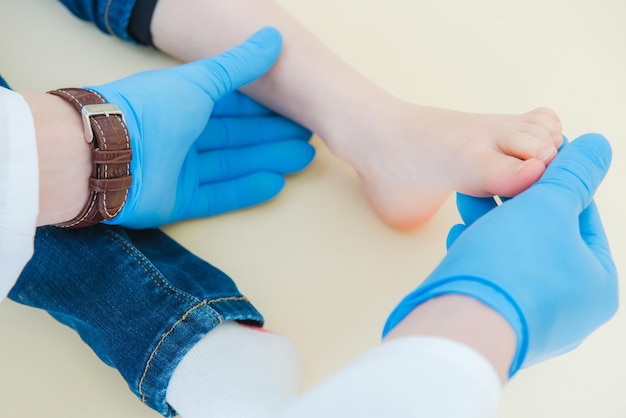Podiatrists are doctors who specialize in feet, ankles, and related structures in the leg. They help people who have issues such as dry heels, ankle pain, toe issues or other challenges related to their feet. For people with diabetes, the stakes are higher – podiatrists are a critical part of any diabetic treatment team, and knowing when to visit them can make a big difference in someone’s overall health.
Here at Achilles Foot and Ankle Center, we get questions about this all the time: “Why do I need a podiatrist?”, “How often should diabetics and non-diabetics get their feet checked?” and, of course, “What will my insurance cover?”
We think this information is important for anyone to have handy. So, we’ve developed this helpful list of 12 signs it’s time to see a podiatrist. This information can benefit everyone, though people with diabetes will find it particularly critical to follow.
1) It’s the doctor’s orders.
People often first mention foot & ankle issues to their family doctor, since this is the medical professional they see most regularly. Oftentimes, this physician will provide a referral to a podiatrist when patients bring up their feet. Like any medical referral, it’s important to follow it and see the recommended specialist.
2) Certain types of swelling.
It is not unusual for feet to swell after some activity. In fact, just about everyone’s feet are bigger later in the day due to natural swelling (this is why we recommend getting a shoe fitting in the afternoon, rather than the morning). However, some types of swelling are cause for concern. For example:
- Swelling in just one foot;
- Swelling that is extreme, especially if there is also pain;
- Swelling that is persistent and doesn’t go down.
This kind of swelling can indicate an injury, blood clot, heart/circulation problems, or kidney issues. A visit to your family doctor or podiatrist is a good idea in these cases.
3) Unexplainable pain and/or numbness in one or both feet.
Numbness and pain in feet can be a sign of neuropathy. Many find this pain particularly flares up at night or in the morning. Those experiencing unfamiliar pains or numbness should speak to a podiatrist right away.
4) A blister, ulcer or sore that won’t go away.
A small blister is usually not cause for concern in most people. However, those with diabetes in particular may find that a small sore can turn into a large ulcer without proper care. The main signs of serious foot ulcers include black tissue or gangrene around the wound.
Keep an eye out for discoloration around a wound (especially dark colors), pain near the area, or sign of infection. Anything unusual such as this should be looked at by a professional right away, especially if diabetes is involved. Depending on the situation, your doctor or podiatrist might request an immediate appointment to look at any abnormalities, as tiny blisters can become serious problems rather quickly for someone with diabetes.
5) Thick corns or calluses.
Corns and calluses can be extremely uncomfortable, and often the right pair of therapeutic inserts or shoes can help soften the issue. A podiatrist will be able to examine the corns and recommend the best treatment options.
6) Split skin and heel dryness.
Dry skin is a common challenge for many people, but can be particularly prevalent in those with diabetes. Therapeutic inserts and shoes recommended by a podiatrist can make a big difference here. We offer our very own dry skin formula- Achilles Advanced Healing Cream to everyone. The pros for our healing cream improves circulation, protects skin, and speeds healing.
7) Bruising or discoloration on the feet.
It can be quite a shock to see bruising on one or both feet, particularly if you don’t remember any injury taking place. Sometimes, people with peripheral neuropathy can get a foot injury without knowing it – even broken bones might fly under the radar for numb feet! Bruising and discoloration certainly warrant a trip to the podiatrist, especially if the cause of the issue is unknown.
8) Toe issues like ingrown toes or hammertoes
Ingrown toenails, hammertoes and other issues with toes are all things a podiatrist should look into, particularly if toes are causing pain or making it difficult to walk. Any diabetic with such issues should see a podiatrist right away, as the combination of hammertoes and circulation issues can lead to infections and ulcers. Luckily, therapeutic shoes and inserts can often help minimize these risks.
9) Starting a new exercise plan (in some cases).
No, we’re not saying that you need to see a podiatrist every time you plan to go to the gym. However, they should be consulted in certain cases:
- If it will be intensive for your feet, such as training for a marathon;
- If you have diabetes, particularly if you have had foot issues in the past;
- If you need special shoes or inserts to support your new regimen;
- If you have had a foot injury, surgery or challenge in the past and need to be cleared for the new venture.
10) Needing advice, fittings or a prescription for therapeutic shoes.
Anyone can buy therapeutic shoes without a prescription, however a podiatrist can be very helpful in clarifying what type of shoes a person needs. They can also write a prescription for shoes to help people qualify for insurance coverage, as Medicare and most insurers cover shoes for certain diabetic patients.
Along with a prescription and Certificate of Medical Necessity, Medicare and most insurers also require therapeutic shoes to be properly fitted before providing coverage. This will ensure shoes and inserts are perfectly customized to a person’s feet, making them far more comfortable and effective. Shoe fittings can always be done inside our 5 locations.
11) Difficulty adjusting to new shoes.
Podiatrists can offer specific instructions for “breaking in” new shoes (especially therapeutic shoes) without risking an injury, blister or other issues. This advice can be extremely valuable, so make sure to call a specialist if new shoes are giving you trouble. Trying to just “push through” can cause damage, especially in those with pre-existing conditions.
12) Insurance/Medicare covers your visit.
Why visit a podiatrist? Well, for many people the question is “why not?”!
Annual podiatrist visits are covered by Medicare for people with diabetes. Others may have the specialist paid for at least in part by a group insurance plan. Check to see if you are covered – if you are, it’s a worthwhile visit to mark on your calendar. Schedule an appointment with any podiatrist at Achilles Foot and Ankle Center.







[…] evaluation by a podiatrist is advised to ensure proper treatment and prevent further damage that could lead to prolonged recovery. Swelling, bruising, and persistent pain warrant a professional evaluation to identify and address […]
[…] any red flag appears, schedule a podiatric evaluation right away to confirm the diagnosis and start protective treatment. Waiting it out is a gamble your feet […]